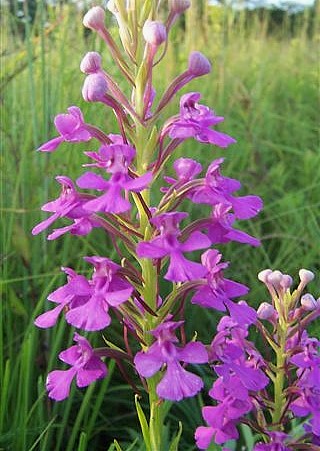Description: This perennial orchid is 1-3' tall and unbranched. The central stem is light green and glabrous. Along this stem, there are 2-5 alternate leaves up to 8" long and 2" across; these leaves become smaller in size as they ascend the stem and they are held more or less upright. The leaf blades are light to medium green, lanceolate-oblong to narrowly ovate, and smooth along their margins; their veins are parallel. The central stem terminates in an elongated raceme of flowers about 3-8" long and 2½" across.

The flowers are arranged somewhat densely all around the
central stalk of the raceme, blooming from the bottom to the top. The
flowers are usually bright rose-purple and less often pale rose-purple.
Each flower is about 1" long and ¾" across, consisting of 3 petal-like
sepals, 3 petals, the reproductive organs, and a nectar spur in the
back (about 1" long) that nods downward. The upper sepal and two upper
petals (about ¼" long) form a small hood (upper lip) above the
reproductive organs. The lowest petal forms the lower lip of the flower
(about ¾" long); it is deeply divided into 3 fan-shaped lobes that are
barely fringed along their lower margins. The central lobe of the lower
lip is larger than the lateral lobes; it usually has a small narrow
notch in the middle of its lower margin. The lower sepals are about
1/3" long and form the sides of the flower; they extend further back
than either the hood or the lower lip. Each flower has a stout
ascending pedicel about 1" long. At the base of each pedicel, there is
an ascending small bract (about ¾" long) that resembles a narrow leaf.
The blooming period occurs during mid- to late summer and lasts about 3
weeks. Fertile flowers are replaced by erect seed capsules about ½–¾"
long that are ellipsoid in shape. The capsules split open to release
numerous tiny seeds that are dispersed by the wind. The root system
consists of fleshy fibrous roots.
Cultivation:
The preference is full sun to light shade, moist conditions, and a
slightly acidic soil that contains loam, silt, or gravel. Because the
root system forms a symbiotic relationship with underground fungi,
individual plants are difficult to transplant. During some years, this
orchid may fail to flower.
Range & Habitat:
Purple Fringeless Orchid is uncommon in southern and SE Illinois, while
in other areas of the state it is absent. This is a native wildflower
of Illinois. Habitats include moist
meadows and prairies, prairie swales, openings in floodplain woodlands,
swamps, moist thickets, gravelly seeps, streambanks, poorly drained
fallow fields, and ditches. This orchid benefits from disturbance that
reduces overhead trees and other kinds of competing vegetation. It is
often found in seasonal wetlands that are flooded during the spring,
but dry out during the summer.
Faunal Associations:
The nectar of the flowers attracts primarily large butterflies and
Sphinx moths. The following floral visitors of Purple Fringeless Orchid
have been observed: Danaus plexippus (Monarch), Papilio
glaucus (Tiger Swallowtail), Papilio troilus
(Spicebush Swallowtail), Speyeria cybele (Great
Spangled Fritillary), Epargyreus clarus
(Silver-Spotted Skipper), Amphion floridensis
(Nessus Sphinx), Hemaris diffinis (Snowberry
Clearwing), Hemaris thysbe (Hummingbird Clearwing),
and Hyles lineata (White-Lined Sphinx). Various
mammalian herbivores (deer, rabbits, cattle, etc.) sometimes browse on
the foliage and flowers of this and other orchids. It may be necessary
to place wire cages around individual plants or erect fences to prevent
the destruction of local orchid populations by these animals.
Photographic Location:
A prairie in Fayette County, Illinois. The photograph of the flowering
plant was taken by Keith & Patty Horn (Copyright © 2009).
Comments:
When this orchid is in full bloom, it is very eye-catching and
beautiful. The only other species in Illinois that are even remotely
similar, viz. Platanthera psycodes (Purple-Fringed
Orchid) and Platanthera grandiflora (Large
Purple-Fringed Orchid), have rose-purple flowers with strongly fringed
lower lips. Because these latter orchids are found only in the northern
section of the state, their ranges do not overlap with the more
southern range of the Purple Fringeless Orchid.